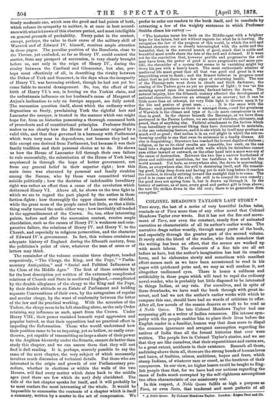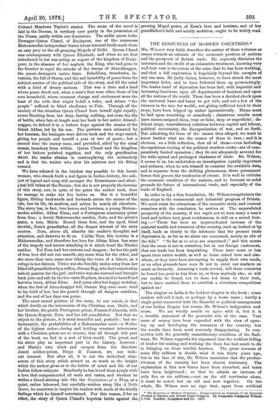COLONEL MEADOWS TAYLOR'S LAST STORY.* THIS story, the last of
a series of very beautiful Indian tales, reminds us of Tara more than of any other novel that Colonet Meadows Taylor ever wrote. But it has not the fire and move- ment of Tara, nor even the constant, steady flow of animated narrative so characteristic of all its author's earlier works. The narrative drags rather wearily, through many parts of the book,. and especially through the greater part of the second volume. It rarely stirs the blood of the reader, who feels somehow that the writing has been an effort, that the scenes are worked up- with much labour. The elements of a fine tale are all set before us here, but the author's imagination has lost its creative force, and he elaborates slowly and sometimes with manifest effort scenes such as we have been accustomed to read in his pages with quickened pulse and, we may as well confess it, not altogether undimmed eyes. There is hence a coldness and artificiality in these pages which will tend to repel the ordinary novel-reader, who is probably but little disposed to be interested in things Indian, at any rate. For ourselves, and in spite of these drawbacks, we have read the book through with great in- terest, and had we not the author's earlier works with which to compare this one, should have had no words of criticism to offer. After all, few novels of the season deserve so well to be read as A Noble Queen. The late Colonel Meadows Taylor had one surpassing gift as a writer of Indian romances. His intense sym- pathy with the people enables him to place their lives before the English reader in a familiar, human way that does more to dispel the common ignorance and arrogant assumption regarding the natives of India than all the formal histories that ever were written. The people live in Colonel Taylor's stories, and we see- that they are like ourselves, that their superstitions and castes are,. to a great extent, accidents in their existence. Beneath all these,. and rising above them all, there are the strong bonds of humanloves and hates, of frailties, crimes, ambitions, hopes and fears, which stamp Indians, of whatever race or creed, as the brethren of their conquerors. In our view, no higher lesson could be taught to Eng- lish people than that, for we have had our notions regarding the races of India much corrupted by the self-righteous assumptions too often characteristic of our missionary zeal.
In this respect, A Noble Queen fulfils as high a purpose as Tara, or even Seeta, that tenderest and most pathetic of all
• el Noble Queen. By Colonel Meadows Taylor. London: Kagan Paul and 0o.. Colonel Meadows Taylor's stories. The scene of the novel is laid in the Deccan, in territory now partly in the possession of the Nizam, partly within our dominions. The noble queen is the Dowager-Queen Chand, of Beejapoor, one of the numerous Mahommedan independent States whose internal broils made them an easy prey to the all-grasping Moguls of Delhi. Queen Chand was contemporary with Queen Elizabeth, and when we are first introduced to her was acting as regent of the kingdom of Beeja- poor, in the absence of her nephew, the King, who had gone to the frontier to repel the attacks of the troops of Ahmednugger, the queen-dowager's native State. Rebellions, treacheries, in- vasions, the fall of States, and the sad instability of peace form the subject-matter of the political side of the story, and fill the mind with a kind of dreary sadness. This was a time and a land where peace dwelt not, when a man's foes were often those of his own household, where constant change and excitement were the least of the evils that might befall a ruler, and where "the people" suffered in blind obedience to Fate. Through all the anxiety of the situation Queen Chand bore herself right royally, never flinching from her duty, fearing nothing, not even the din of battle, when fate at length sent her back to her native Ahmed- nugger, to defend it in a forlorn hope against the armies of the Great Akbar, led by his son. The garrison once animated by her heroism, the besiegers were driven back and the siege raised, giving her people and herself a year or two of peace ; but a second time the enemy came, and prevailed, aided by the usual means, treachery from within. Queen Chand and the kingdom of her fathers perished together, and the only gratification which the reader obtains in contemplating the melancholy end is that the traitor who slew his mistress met his fitting reward.
We have referred in the briefest way possible to this heroic woman, who stands forth a real figure in Indian history, the sub- ject of legend and song still amongst the Mussulmans and abori- ginal hill tribes of the Deccan ; but she is not properly the heroine of this story, nor, in spite of the pains the author took, does he manage to make her live before us. She is a beautiful figure, flitting backwards and forwards across the scenes of the tale, but its life, its motives, and action lie nearly all elsewhere. The story has, in fact, two heroes and heroines, a young Mahom- medan soldier, Abbas Khan, and a Portuguese missionary priest from Goa ; a lovely Mahommedan maiden, Zora, and the priest's sister, a nun, Maria. Round these four, and the aged, blind dervish, Zora's grandfather, all the deeper interest of the story centres. Zora, above all, absorbs the reader's thoughts and attention, and deserves to do so. Unlike Tara, this heroine is a Mahommedan, and therefore her love for Abbas Khan has none of the tragedy and horror attaching to it which beset the Hindoo maiden. Yet Zora had her sorrows and dangers ; for her the path of true love did not run smooth, any more than for the other, and she more than once came near taking the vows of a fakeer, as a refuge in her distress. Twice was she forcibly stolen away from her blind old grandfather by a ruffian, Osman Beg, who had conceived an unholy passion for the girl ; and twice was she rescued and brought back pure and safe by the low-caste Beydurs, devoted to herself and her true lover, Abbas Khan. And years after her happy wedding, when the fort of Ahmednugger fell, Osman Beg once more tried to lay hold of her, but she passed through all dangers scathless, and the end of her days was peace.
The most unreal portion of the story, to our minds, is that which dwells on the intercourse of the Christian nun, Maria, and her brother, the gentle Portuguese priest, Francis d'Almeida, with the Queen-Regent, Zora, and her old grandfather. Not that we object to the picture, it is most beautiful and pathetic ; but un- fortunately, the probabilities of a Mahommedan saint—a Wallee of the highest order—loving and holding constant intercourse with a Christian priest are so remote, that all through this part of the book we feel in a sort of fairy-world. The priest and his sister play an important part in the history, however ; and Maria's own trials and escapes from the dissolute Jesuit soldier-priest, Diego di Fonseca, are not with- out interest. But after all, it is not the individual char- acters of this story which attract us, so much as the insight which the author gives as to the habits of mind and life of our Indian fellow-subjects. Manifestly be has loved these people with a love that comprehended all sects and castes, and whether he writes a blood-stirring tale like the Confessions of a Thug, or a quiet, rather laboured, but carefully-written story like A Noble Queen, he contrives to inspire his readers with much of the kindly feelings which he himself entertained. For this reason, if for no other, the story of Queen Chand's hopeless battle against the
growing Mogul power, of Zora's love and heroism, and of her grandfather's faith and saintly ambition, ought to be widely read.



































 Previous page
Previous page